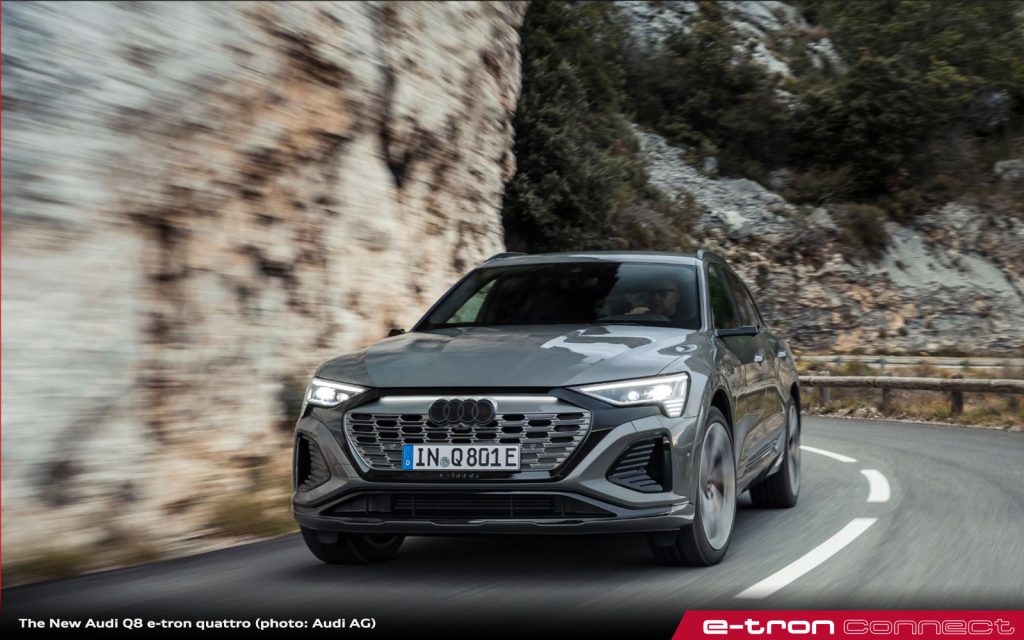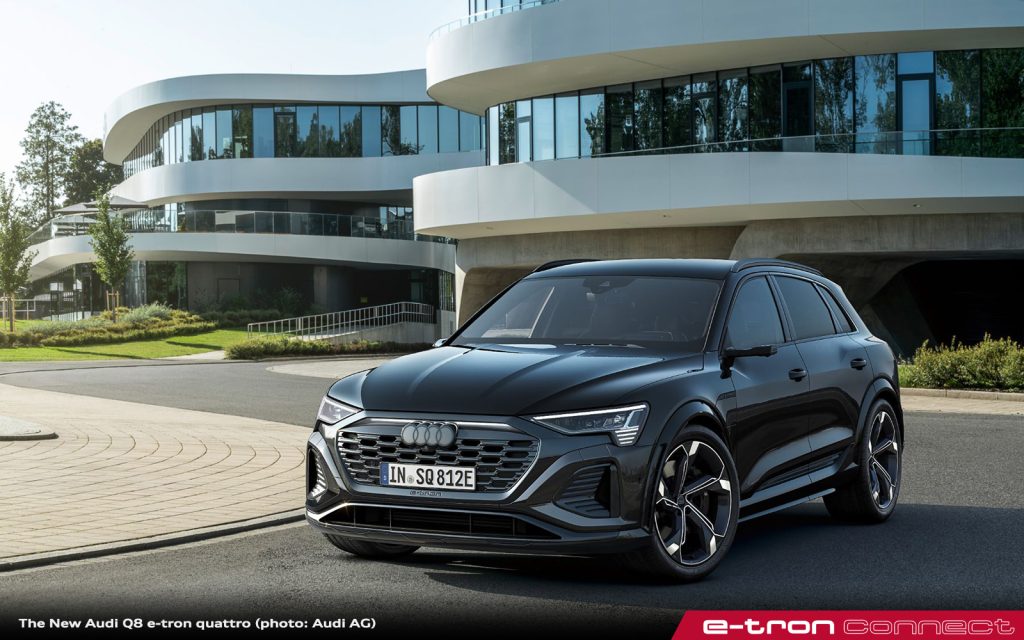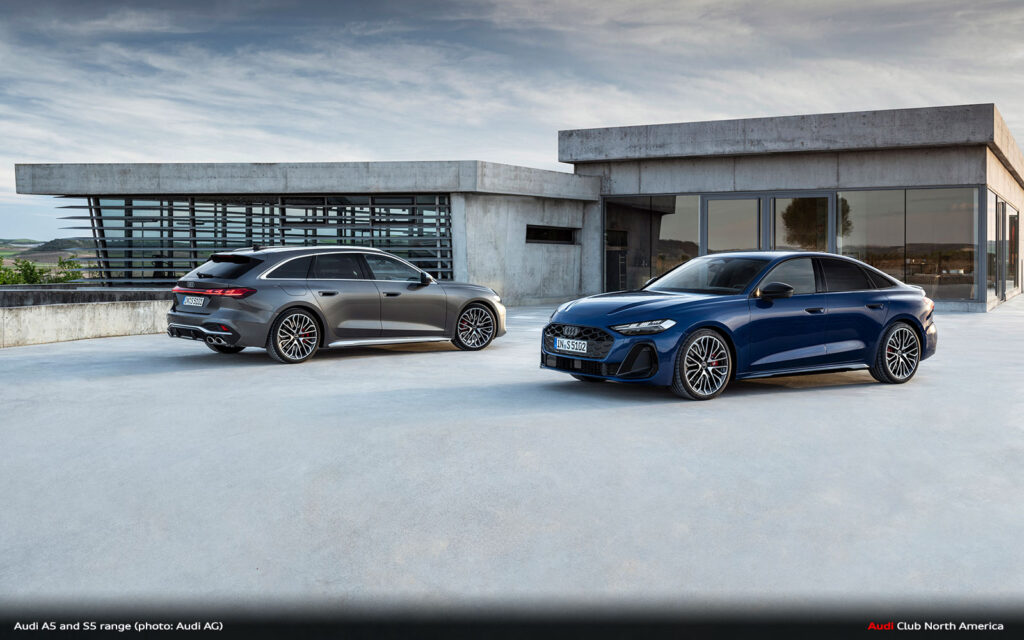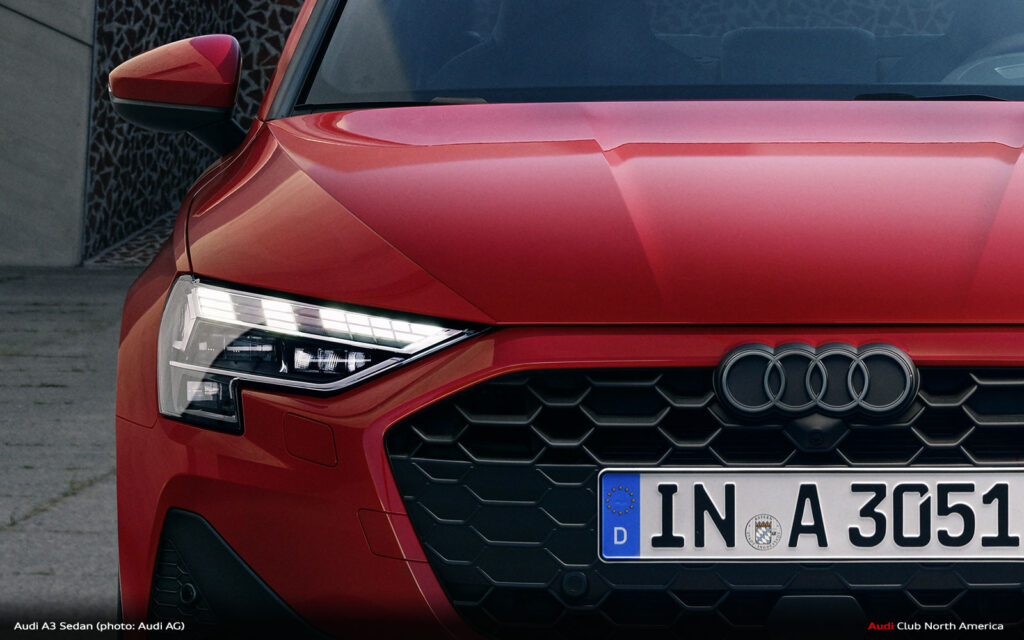
The New Audi Q8 e-tron: Improved Efficiency and Range, Refined Design
source: Audi AG
Editor’s note: To see more videos of the Audi Q8 e-tron, please visit our YouTube channel HERE.
- More battery capacity and higher charging performance
- Fresh exterior, new brand design, and dynamic driving characteristics
- Net-carbon-neutral production and the first-time use of recycled materials in a safety-related component
With the Audi e-tron, the premium manufacturer entered the age of electromobility in 2018, marking the start of the electric future for the four rings. Since then, the model has been setting standards in the electric luxury-class SUV segment. The new Audi Q8 e-tron is now building on the success story of this electric pioneer. The top-of-the-line electric SUV and crossover impress with their optimized drive concept, improved aerodynamics, higher charging performance, and battery capacity and increased range of up to 582 kilometers in the SUV version (in accordance with the WLTP) and up to 600 kilometers in the Sportback version (in accordance with the WLTP). Significant changes, especially at the front of the vehicle, lend the new flagship SUV a fresher appearance.
Since the introduction of the Audi e-tron around four years ago and sales of 150,000 units, Audi has been following a systematic electric roadmap. Its electric portfolio now comprises eight models. By 2026, it will have more than 20. At that point, Audi will only be releasing fully electric models on the global market. “With our corporate strategy ‘Vorsprung 2030’, we’ve set a fixed date for our withdrawal from combustion engines and clearly decided that Audi will be a fully electric brand within 11 years,” said Markus Duesmann, Chairman of the Board of Management of AUDI AG. “The new Audi Q8 e-tron, with its improved efficiency and range and refined design, is another important component in our electric portfolio to get people excited about electromobility with emotional models that are suitable for everyday use.” Audi Board Member for Technical Development Oliver Hoffmann also focused on the customer benefits enhanced by these refinements. “In the new Q8 e-tron, we were able to significantly increase both battery capacity and charging performance. This allowed us to achieve an optimal balance between energy density and charging capacity, as well as to increase efficiency,” Hoffmann said. “On top of that, we improved the motors, progressive steering, and chassis control systems – and thus the dynamic driving characteristics that are typical of Audi in all versions of the Q8 e-tron.”

New face, new name, new corporate identity
By calling this model the Q8, Audi is making a clear statement that the Audi Q8 e-tron is the top model among its electric SUVs and crossovers. The Audi Q8 e-tron and Q8 Sportback e-tron are immediately identifiable as fully electric models at first glance. This is thanks to the new front and rear designs with the characteristic Singleframe mask, the inverted grille, and blade above the redesigned rear diffuser, which systematically carry Audi’s electric design language forward. An exclusive highlight on the edition S line package is the Singleframe grille, which is finished in body color.
As a prestigious electric SUV model from Audi, the Q8 e-tron ushers in the new corporate identity with a two-dimensional design of the four rings on the exterior. In order to elevate the family logo as a central element, Audi highlights the vehicle’s face with the projection light Singleframe. Additionally, the Q8 e-tron is the first model to feature the new model badge with Audi lettering on the B-pillar.
Maximum amount of space and comfort
With a vehicle length of 4.915 meters, a width of 1.937 meters, and a height of 1.619 meters for the Sportback and 1.633 meters for the SUV, the Q8 e-tron offers a maximum amount of space and comfort. The SQ8 e-tron2 and SQ8 Sportback e-tron3 are each two millimeters lower and 39 millimeters wider. Its wheelbase of 2.928 meters allows for a lot of legroom in the back seats too. It has a generous storage volume of 569 liters for the SUV and 528 liters for the Sportback. There are also 62 liters available in the front storage area, the so called “frunk”.

Three drivetrain variants
For both body shapes, three drivetrain variants with electric all-wheel drive can be selected. With their two motors, the base models of the Audi Q8 50 e-tron and the Audi Q8 Sportback 50 e-tron generate 250 kW in boost mode and 664 Nm of torque, and they get a range of up to 491 km (SUV) and up to 505 km (Sportback), in accordance with the WLTP.
With their two motors, the Audi Q8 55 e-tron and Audi Q8 Sportback 55 e-tron generate 300 kW in boost mode and 664 Nm of torque. Their ranges are up to 582 km for the SUV and up to 600 km for the Sportback, in accordance with the WLTP. Their top speed, and that of the Q8 50 e-tron, is limited to 200 km/h.
The top-end Audi SQ8 e-tron and Audi SQ8 Sportback e-tron are powered by three motors. Their boost performance amounts to 370 kW and 973 Nm of torque.
The range of the S models is up to 494 km for the SUV and up to 513 km for the Sportback. Their top speed is limited to 210 km/h.
More battery capacity and higher charging performance
Two battery sizes can be selected. The battery of the Q8 50 e-tron has a storage capacity of 89 net kilowatt-hours (95 gross kWh), while the more powerful versions of the Q8 55 e-tron6 and SQ8 e-tron have 106 net kWh (114 gross kWh). Thanks to an adjustment to the battery management system, the battery capacity usable for customers has increased as well. At a high-powered charging station, the Audi Q8 50 e-tron reaches a maximum charging performance of 150 kW. With the Q8 55 e-tron and SQ8 e-tron, the maximum charging performance increases to up to 170 kW. The big battery can be charged from ten to 80 percent during a roughly 31-minute charging stop – under ideal conditions, this corresponds to a range of up to 420 kilometers (according to WLTP). At an AC charging station or wallbox, the Audi Q8 e-tron charges at up to 11 kW. Audi offers an optional AC charging performance of up to 22 kW.
Under ideal conditions, the Audi Q8 50 e-tron can completely charge in around nine hours and 15 minutes (22kW: around four hours and 45 minutes) using alternating current. The big battery’s numbers are around 11 hours and 30 minutes at 11 kW and six hours at 22 kW. The Audi Q8 e-tron comes standard with the Plug & Charge function. At compatible charging stations, the vehicle authorizes itself when inserting the charging cable and activates the charging point. Billing happens automatically. The new charging service Audi charging, which is set to launch in 2023 and will in the future replace the existing e-tron Charging Service, will allow for convenient access to around 400,000 public charging points across Europe. The e-tron route planner provides reliable support when searching for charging points along your route.
Revised rear-axle motor and electric torque vectoring for better dynamics
For the new Audi Q8 e-tron, the asynchronous motor concept on the rear axle was modified. Instead of 12 coils generating the electromagnetic field, there are now 14. The motor consequently generates a stronger magnetic field with similar electricity input, which in turn allows for more torque. If this isn’t needed, the electric motor requires less energy to generate torque. This lowers consumption and increases range. With the e-tron range’s S model, Audi used a three-motor concept for the first time in large-scale production.
This was refined for the new SQ8 e-tron. A 124-kW electric motor is at work on the front axle. On the rear axle, there are two electric motors each with 98 kW of output that each separately power a rear wheel. This allows for a boost performance of up to 370 kW. The drive torque can be distributed across both rear electric motors between both wheels within a split second.

Balancing act between comfort and sportiness
The new Audi Q8 e-tron comes standard with an air-spring suspension with controlled shock absorption. The height of the car body can be varied by a total of 76 millimeters, depending on the driving situation. To optimize the lateral dynamics of the vehicle, its air-spring tuning was adjusted. Moreover, its electronic stability control (ESC) will allow for even more maneuverability in the future – especially in tight corners. The Audi Q8 e-tron handles these with noticeably more agility thanks to its revised progressive steering. The gear ratio of the steering system was changed so that the steering responds much more quickly, even when making delicate steering movements. The effect of the direct steering ratio is supported by more rigid suspension bearings on the front axle. Steering movements are thus transmitted to the wheels more directly, and feedback from steering reactions is improved as well. All the chassis control systems were adjusted, but they remain balanced and perfectly attuned – true to the Audi DNA.
Further improved aerodynamics
With the Audi Q8 e-tron, the topic of aerodynamics was a top priority. This resulted in a reduction of the drag coefficient from 0.26 to 0.24 cw for the Q8 Sportback e-tron and from 0.28 to 0.27 cw for the Q8 e-tron. The wheel spoilers mounted on the underbody help divert airflow around the wheels. The spoilers on the front axle were enlarged, and the Audi Q8 Sportback e-tron now has spoilers on the rear wheels as well. With the SQ8 Sportback e-tron3, spoilers are only mounted on the rear axle. In the area around the grille, this is the first time an Audi model has had a self-sealing system in addition to the electric shutters that automatically close the radiator. This system further optimizes the airflow at the front of the car and prevents undesired losses.













Responses